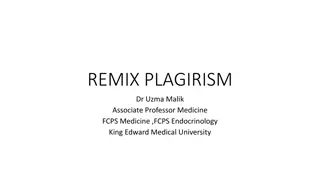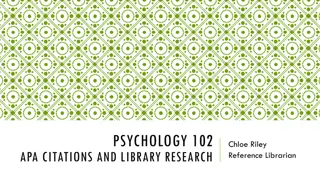Understanding Plagiarism: Importance and Strategies for Students and Faculty
Explore the significance of plagiarism in academic settings and learn strategies to educate students on avoiding it. Discover best practices for addressing suspected cases of plagiarism and find resources for faculty and students to promote academic integrity.
Download Presentation

Please find below an Image/Link to download the presentation.
The content on the website is provided AS IS for your information and personal use only. It may not be sold, licensed, or shared on other websites without obtaining consent from the author. Download presentation by click this link. If you encounter any issues during the download, it is possible that the publisher has removed the file from their server.
E N D
Presentation Transcript
Beg, Borrow or Steal Why Plagiarism Matters to Students and Faculty July 19, 2021
Objectives Define plagiarism, its common forms, and why knowledge of plagiarism is important in the context of student learning. Gather strategies for teaching activities that help students avoid plagiarism. Gather best practices for how to talk to students about plagiarism. Outline the steps to follow when plagiarism is suspected. Summarize plagiarism resources for faculty and students.
Academic Integrity Policy: Plagiarism: includes, but is not limited to: a) failure to give full and clear acknowledgement of the source of any idea that is not your own; b) handing in the same assignment for two different courses without the consent of the instructors. Context for this session: written work Define Plagiarism
What comes to mind when you think of plagiarism?
Stephanie Guedet, PhD. Associate Professor of English (CUW) Subject matter expert for Accelerated Learning courses (Centers, Online) "Talk about plagiarism by not talking about plagiarism" https://cuwaa.hosted.panopto.com/Pa nopto/Pages/Viewer.aspx?id=e076345 3-5299-45fd-b20f-ad35012fd153
Fail to give credit through accurate in-text citations and reference lists Skill-based Types of Plagiarism Improper Citing Copy a source word-for -word without proper credit or citations Copy & Paste Improper paraphrase of a source by only changing a few words or phrases Find & Replace Source
Time-based Types of Plagiarism Submit the work of another student Sharing Work Reuse work from previous courses, in part or whole Self- Plagiarism Submit sections from or entire purchased assignments Purchasing Source
Brian Curry, PhD Assistant Vice President, International Affairs Former MBA Program Director Plagiarism from an international student perspective https://cuwaa.hosted.panopto.co m/Panopto/Pages/Viewer.aspx?id =3722c19a-5243-4b30-924f- ad330102af1f
Talking to students early about plagiarism Preventing Plagiarism What might you try? What have you done?
Break up large assignments with multiple deadlines Include practice activities for paraphrasing and citation of short excerpts. Provide timely feedback on errors early Set up a Blackboard Assignment ("drop box") for draft papers - students receive a SafeAssign Originality Report to review their papers before final submission instructor Video explaining how to set up a Blackboard Assignment and set for SafeAssign. Key Assignment settings for draft papers (next slide). Resources to share and discuss Purdue OWL Plagiarism Overview Six Common Types of Plagiarism (infographic) The Writing Center CUAA Writing Center CUW Writing Center TutorMe (Center and Online Students) Effective paraphrasing More Ideas to Help Students Avoid Plagiarism
Key Assignment Settings for Draft Papers Unlimited Attempts
Miller Park Way Center Director Adjunct Instructor (Centers) https://cuwaa.hosted.panopto.com/Panopto/Pages/Viewer .aspx?id=eb2ad04f-983e-4cfb-a067-ad34010bc0b7 Diana Belscamper, PhD
Randomly check citations Look for dated references Notice inconsistent formatting Notice varied elements of style or word choice Pay attention to sections that are off topic Google a phrase or sentence SafeAssign Direct Submission SafeAssign Originality Report Detecting Plagiarism Tools and Ideas for Instructors Harris, R. (2020, October 31). Anti-Plagiarism Strategies. VirtualSalt. https://www.virtualsalt.com/anti-plagiarism-strategies-for-research-papers/.
"I think my student plagiarized: What do I do now?" Draw on relationship built with student DO consider students individual circumstances Not as an excuse, as a starting point for learning Number of offenses, amount and context all may contribute to full picture Consider working from a script or have written talking points fact-based DO call, Zoom or meet with student F2f, one-on-one DO NOT email However, document the interaction consider sending a summary email afterward DO listen attentively and ask questions, DO NOT use threatening language. Some conversation starters that avoid accusation (Harris, 2020): I was quite surprised by your paper, so I did some investigation into it. Before I tell you what I found out, is there anything you want to tell me about it? I m curious to know why your writing style is so good in some parts of the paper and so poor in others. And why have you not shown such great writing on the in-class essays? This long passage doesn t sound like your normal style. Is this a quotation where you accidentally forgot the quotation marks? Explain to me again what the rules for paraphrasing or summarizing are. Some of the passages in your paper make me think you might be unclear about them. Harris, R. (2020, October 31). Anti-Plagiarism Strategies. VirtualSalt. https://www.virtualsalt.com/anti-plagiarism-strategies-for-research-papers/.
Elizabeth Polzin, Assistant Vice President of Academics for Student Success Best practice with engaging students in conversation about plagiarism When do I report instances of plagiarism and what is required? What happens after I file a report?
Concordia Reporting Process The Academic Dishonesty Reporting Form is in the Forms Repository on the portal Elizabeth Polzin























